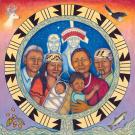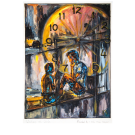We are Still Here: Expression of Self - Art Inspired by Lyn Risling
7.VA:CN11, 7.VA:RE7.1, 7.VA:RE7.2, 7.VA:RE8, RI.7.7, W.7.1, SL.7.1, SL.7.2In this final lesson of the art and Karuk language integrated unit, students will have the opportunity to create original artwork inspired by Lyn Risling’s painting We Are Still Here, Fix the World People. The lesson focuses on the use of symbolism in Indigenous art, encouraging students to integrate their personal, cultural, or ancestral expressions into their own creations. To begin, the teacher will revisit the subjects and symbols in Lyn Risling’s painting, such as the river, animals, plants, and ceremonial items, explaining their cultural significance. For example, the river represents life and the health of the people, animals can symbolize spiritual connections to fix the world ceremonies, and plants like acorns are essential traditional food.



